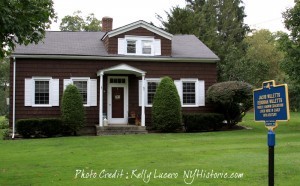
Millbrook home of Jacob and Deborah Willets, Quaker educators at Nine Partners School who participated in Underground Railroad activity–helping enslaved New Yorkers escape to Vermont or Canada
The Underground Railroad (UGRR) really existed, and it helped many enslaved people–not only in the South, but also in the early 1800s New York, New Jersey, and other northern slaveholding states–escape to freedom.
The Underground Railroad has also been, however, the source of much myth-making and wishful romance. Before the U.S. Civil War (1861-1865), only a small minority of white Northerners engaged in active protest against slavery, including aid to those seeking freedom. After the Civil War, when Emancipation and the service of African American soldiers had aided Union victory, the myth arose that most white Northerners had been longtime abolitionists.
If you believe a property may have been used on the Underground Railroad, here are some questions to ask and strategies for proceeding with your research.
1) Check the date when the house was built. If construction occurred after 1865, when the Civil War ended, there is no chance that UGRR activity could have taken place.
2) At your county clerk’s office, or wherever historical deeds are stored in your locality, research the property to determine who owned it between the American Revolution and the Civil War (roughly 1790-1860). If the names of owners or occupants can be found, research their identities at your local library. (The identities of tenants in rented buildings are often elusive; city or county directories may help.) You may be able to locate census records, newspaper obituaries and clippings, or information from local religious congregations. Genealogical societies may also be able to help. Historical books and newspapers in your library may even have records of local abolitionist groups, such as rosters of those who signed petitions or attended antislavery meetings.
If the occupants of your house were free African Americans, supporters of a local abolitionist society, or Quakers or members of another local religious community that took a stand against slavery, that significantly increases the chances that the site may have been used for UGRR activity. There are rarely guarantees. Occasionally, one may find an interview with a descendant or neighbor confirming such activity. More likely, you may be able to confirm, at best, that abolitionists lived in the house.
3) If any African American families lived in the house, the census may yield additional clues. Naturally, before the Civil War, few African Americans who had escaped from slavery told U.S. census takers that they had been born in the South. After Emancipation they were freer to do so. So if an African American told census takers in 1860 that he or she was born in, say, “New York,” but in 1870 identified herself or himself as born in a slave state (such as “Maryland” or “Virginia”), that may be evidence that the person had escaped from slavery. More research would certainly be warranted to uncover the stories of such possible freedom-seekers.
Passage of the draconian federal Fugitive Slave Act in 1850, which led some African Americans to flee temporarily to Canada, offers additional powerful clues. If a family identified themselves in 1870 as born in the South, and if any children in the family were born in Canada during the 1850s, this is additional strong evidence that the family had escaped from enslavement.
4) The best evidence for UGRR activity is not a tunnel, hidden closet, or secret room. Such spaces may have been used for many purposes. In the Hudson Valley these included smuggling along the Hudson River and the protection of Patriots or Loyalists during the American Revolution. Many old houses also included tiny servants’ rooms and secure basement spaces where vegetables and other food supplies could be secured from animals. Repeated renovations of a building may close off spaces that are “rediscovered” later on.
If you do find a hidden space, you may be able to find clues about its purpose and dates of use if there are discarded bottles, tools, newspapers, clothing, or other items in the room. Again, however, return to step #2 above: the most crucial evidence is not any architectural feature, but the identities of those individuals who lived in the house.
Keep in mind that you may find evidence of slavery as well as antislavery. Residents of the Hudson Valley have found manacles in the basements of colonial houses, as well as other artifacts from the long era (early 1600s to 1820s) during which slavery was legal and common in New York. Depending on the era, property and census records may (as above) help confirm that slaveholders and enslaved people lived or worked in a house.
Such findings may be more disturbing than evidence of UGRR activity, but historical artifacts from the era of slavery are also valuable and far too often overlooked. If you do find historical evidence of slavery in a property you own, be sure to preserve the evidence and contact your local historical society for evaluation.
MHAHP is a volunteer community organization with very limited research resources, but we are happy to confer with residents of the Hudson Valley about any possible site related to slavery, antislavery, or the UGRR.
MHAHP wishes to thank distinguished historian Judith Wellman, of SUNY Oswego for her training and guidance in local UGRR research. MHAHP takes full responsibility for the information published here.